#William Tuthill
Text




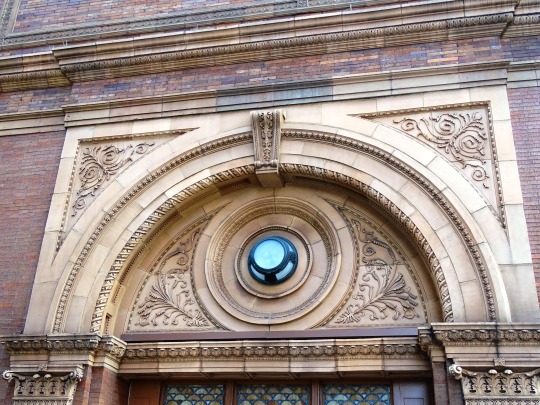
Carnegie Hall reopened after a $50 million facelifting on December 15, 1986.
#Carnegie Hall#881 Seventh Avenue#reopened#15 December 1986#travel#anniversary#US history#Midtown Manhattan#New York City#vacation#summer 2018#original photography#architecture#cityscape#façade#landmark#tourist attraction#William Tuthill#Richard Morris Hunt#Adler & Sullivan#Italian Renaissance style#marquee#USA
2 notes
·
View notes
Photo
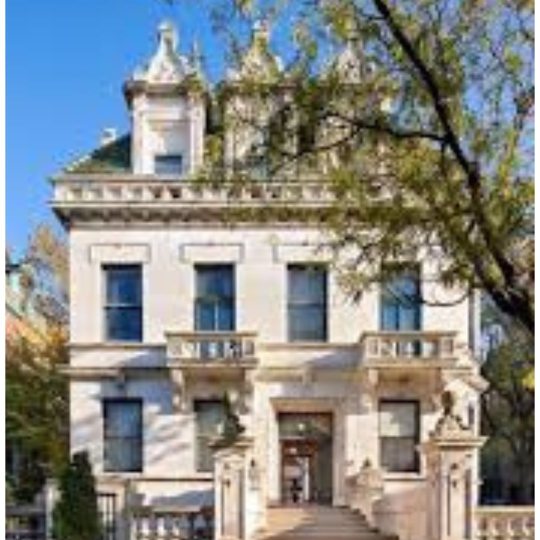
Did you know? The Schinasi Mansion at 351 Riverside Dr, the last privately owned freestanding mansion in Manhattan, has history and quirks as rich as its French Renaissance architecture. The mansion was commissioned by Morris (originally Mussa) Schinasi, a Turkish immigrant who became wealthy from his invention of a cigarette rolling machine – and use of strong Turkish tobacco. The architect was none other than William Tuthill, known for his design of Carnegie Hall (1891). Despite his wealth, Schinasi refused to pay Tuthill – who sued. Why Schinasi wouldn’t pay is a mystery – as is the secret tunnel (now sealed) from the mansion’s basement to the Hudson River. Morris Schinasi lived in the house until he died in 1928; his family sold the mansion in 1930 and it became the Semple School for Girls, a finishing school. Rosa Semple, the school’s founder, herself died in the mansion in 1956. Columbia University bought the property in 1960 and established “Children’s Mansion Day Care Center.” Columbia decided to sell in 1979 – to Hans Smit, one of its own law professors, who wanted to restore and resell the home. After nearly three decades of slow interior restoration, Hans Smit (who never lived in the house) tried to sell – but he died in 2012. His son succeeded in selling Schinasi Mansion in late 2013. #funfactfriday (at Schinasi Mansion) https://www.instagram.com/p/Cgm7xgZvf9O/?igshid=NGJjMDIxMWI=
0 notes
Text
Here's where to go if you're a music lover touring New York
New York native and music lover Ronald Phillips says that his city is one of the best places in the world for creatives. Many musicians have been discovered while performing in New York through the years. The music industry's biggest artists consider a sold-out concert in the city proof of their success.

Below, Ronald Phillips shares his favorite must-see landmarks for music lovers exploring New York.
Carnegie Music Hall
Built by philanthropist Andrew Carnegie in 1891 and designed by architect William Burnet Tuthill, Carnegie Hall continues to be a sought-after venue for classical and pop music. In addition, with three auditoriums, it has been the venue for live recordings and concerts.
Ronald Phillips of New York mentions music's biggest stars performed in the venue, including James Taylor, Simon & Garfunkel, Nina Simon, The Beatles, and Rolling Stones.
The Apollo Theatre

To this day, the Apollo Theatre in Harlem continues to be the greatest African American theatre. Even as early as in the '30s, the theatre employed African American talents, which led to the discovery of legends like Billie Holiday.
Ronald Phillips of New York shares that in the '60s, Jimi Hendrix was discovered when he performed in Amateur Night at the Apollo.
In the '80s, it also became the venue for Showtime at the Apollo, which featured the best musical artists. The show ran from 1987 to 2008, introducing audiences to many amazing acts. Michael Jackson, Stevie Wonder, and Aretha Franklin were some of the inductees into the Apollo Legends Hall of Fame.
Radio City Music Hall
This iconic music venue in Rockefeller Center is a true New York landmark. Despite threats of closure and numerous renovations, Ronald Phillips says that Radio City Music Hall continues to be a cultural center that caters to people from different generations.
The venue has hosted the industry's most-awaited events, such as the Tony Awards, Grammy Awards, Daytime Emmy Awards, MTV Video Music Awards, and America's Got Talent. The venue's most notable performers include Lady Gaga, Tony Bennett, Christina Aguilera, Pink Floyd, and Mariah Carey.
0 notes
Text
Four Places to Visit in NYC

Julie Cox and Naomi Cox standing in front of NYC building Carnegie Hall. (Jasmine Torres 3/9/2020).
Most buildings in NYC have a lot of rich history and culture including the famous Carnegie Hall. The idea to construct this luxurious music hall was from an American Industrialist Andrew Carnegie who opened the hall in 1891.
Carnegie was inspired to build this venue for his wife Louise because she sang with the Oratorio Society of New York. Afterward, a man named William Burnet Tuthill, architect and cellist was hired to construct this hall; however, he never made such a thing before. But that didn’t stop him from making one of the most luxurious and beautiful halls in America.
Not only should one visit Carnegie Hall for its marvelous performers, but just looking inside will take your breath away. I highly recommend purchasing a ticket to see one of their shows specifically in the Stern Auditorium which fits 2,804 red seats that are divided into the parquet, first tier, and second tier. Tuthill cleverly designed this auditorium to that there is no bad seating.
The Stern Auditorium has the best acoustics and is the only hall I’ve personally played at and seen. A few tips before planning your visit is this location is typically for adults however Carnegie does host a few family-friendly events. Tickets can range from $30 to $150.
Their hours are from Monday through Friday 11 AM to 8 AM and Saturday through Sunday from 12 PM to 8 PM. After seeing a wonderful show one can go to the gift shop. After my school finished their performance and was relaxing in the practice room, my mother happened to find time to get me some souvenirs from the gift shop.
Sources: https://www.cntraveler.com/activities/new-york/carnegie-hall#:~:text=Carnegie%20Hall%20has%203%2C671%20seats,first%20tier%2C%20and%20second%20tier. https://www.carnegiehall.org/About/History https://www.carnegiehall.org/About/Press/A-Short-History
1 note
·
View note
Text
AF-262: Anna Tuthill Symmes Harrison: America's First Ladies #9
Though she was only First Lady for a month, and never actually went to D.C. during her husband’s brief presidency, Anna Symmes, a wife of ninth U.S. President William Henry Harrison, was an intriguing woman in her own right. A wife and grandmother of U.S. presidents, with a unique upbringing, here is her fascinating story.
Podcast Show Notes:
https://ancestralfindings.com/americas-first-ladies-anna-tuthill-symmes-harrison/
Click Here to listen to the weekly podcast:
https://ancestralfindings.com/podcast
Weekly Giveaways:
https://ancestralfindings.com/drawing
Genealogy eBooks:
https://ancestralfindings.com/ebooks
Hard To Find Surnames:
https://ancestralfindings.com/surnames
Social Media:
https://www.facebook.com/AncestralFindings
https://www.instagram.com/ancestralfindings
https://www.twitter.com/ancestralstuff
Support Ancestral Findings:
https://ancestralfindings.com/donation
#Genealogy #AncestralFindings #FirstLady
Check out this episode!
0 notes
Photo




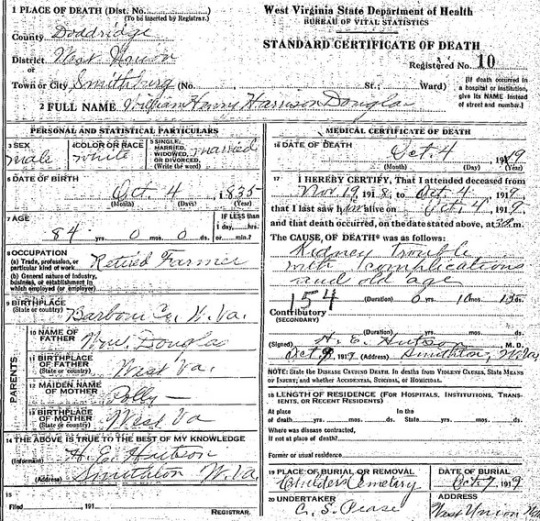

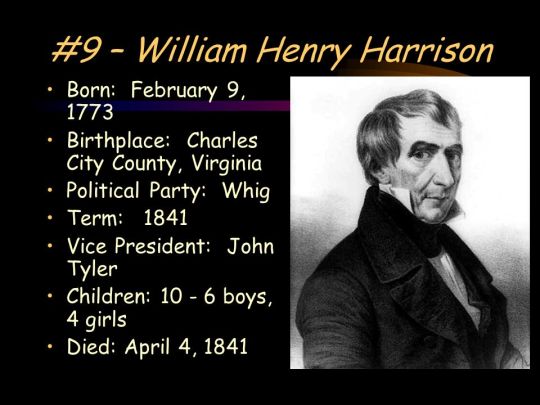



THIS DAY IN HISTORY
FEBRUARY 09, 1773
William Henry Harrison is born
On February 9, 1773, future President William Henry Harrison is born on the Berkeley Plantation in Virginia.
Harrison went on to serve as the ninth U.S. president for a brief 32 days in 1841, the shortest term ever served. Harrison is also credited with the record for the longest inaugural address in history. Delivered on a bitterly cold March morning, it clocked in at one hour and 45 minutes. He was also the last president to be born an English subject.
A native of Virginia, Harrison grew up in a wealthy, politically active household–his father served as governor of Virginia for three terms. He attended college with the intent of studying medicine, but opted to join the army before finishing his degree. As a soldier, Harrison earned a reputation for bravery for his participation in the Indian Wars of the Northwest Territories and the Battle of the Thames River in Ontario during the War of 1812. John Adams appointed Harrison secretary of the Northwest Territories (present-day Indiana and Illinois) in 1798 and shortly thereafter he accepted Adam’s offer to serve as the region’s governor.
In 1811, Harrison earned the nickname Old Tippecanoe after leading a brutal, but successful, attack against Tecumseh’s Shawnee tribe at Tippecanoe Creek in what is now Indiana. As governor, Harrison drew up several restrictive and one-sided treaties with Native American tribes who held desirable land. In one of his stingiest treaties, he agreed to pay a tribe a mere one cent for every 200 acres, a deal which gave the United States 51 million acres for a pittance and opened a wide swath of the West to white settlement.
Harrison married Anna Tuthill Symmes in 1795. The couple had eight children of their own; Harrison also adopted Anna’s son John from a previous marriage. Six of his children died prior to Harrison’s campaign for the presidency. Daughters Mary and Elizabeth survived their father, but only by several years. His last remaining child, Anna, died in 1865.
Boosted by a successful military and political career, which included stints in the U.S. Congress, Ohio Senate and as U.S. ambassador to Colombia, Harrison ran for president in 1840, choosing John Tyler to run with him on the Whig Party ticket. Much to the horror of the political establishment, the two men campaigned vigorously, setting the tone for future campaigns. They employed catchy campaign slogans such as Tippecanoe and Tyler, too, and held boisterous rallies during which they handed out free bottles of hard cider housed in little log cabin-shaped bottles.
Harrison caught a cold on the day of his inauguration that lingered, eventually turning into a fatal case of pneumonia. Some historical records indicate that doctor-prescribed remedies for the pneumonia also gave Harrison a deadly case of hepatitis. He died on April 4, 1841, leaving behind his widow Anna and three surviving children. His grandson, Benjamin, followed in Harrison’s political footsteps, serving a full term as president from 1889 to 1893.
0 notes
Photo
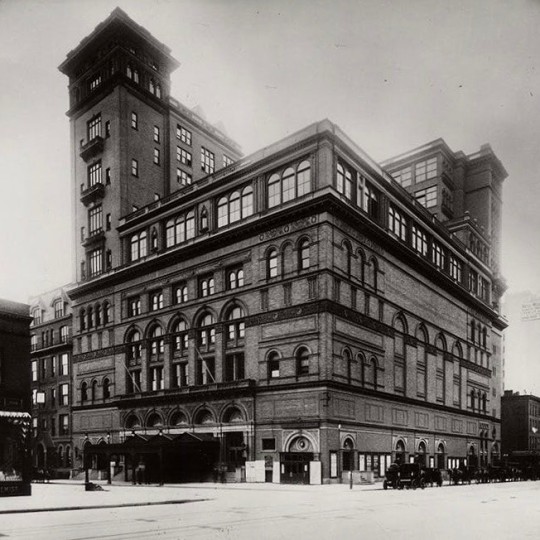
CARNEGIE HALL (first pic from 1899) Carnegie Hall but more commonly is a concert venue in Midtown Manhattan in New York City, United States, located at 881 Seventh Avenue, occupying the east side of Seventh Avenue between West 56th Street and West 57th Street, two blocks south of Central Park. Designed by architect William Burnet Tuthill and built by philanthropist Andrew Carnegie in 1891, it is one of the most prestigious venues in the world for both classical music and popular music. Carnegie Hall has its own artistic programming, development, and marketing departments, and presents about 250 performances each season. It is also rented out to performing groups. The hall has not had a resident company since 1962, when the New York Philharmonic moved to Lincoln Center's Philharmonic Hall (renamed Avery Fisher Hall in 1973 and David Geffen Hall in 2015). Carnegie Hall has 3,671 seats, divided among its three auditoriums. @glrosario @luxestoneny #glrosario George L. Rosario NYC's Hometown Realtor Luxe Stone New York at eXp Builder/Speaker/Entrepreneur CONTACT: 347-671-SOLD www.GEORGEROSARIO.com #NYCsHometownRealtor #eXpRealty #NewYork #NewYorkCity #LuxeStoneNY #arts #music #LIONSquad #Manhattan #carnegiehall #midtown #NYC #MusicHall #performance #artist #musicians #instrumental #exprealtyproud #exprealynyc #exprealtyny #culture #audience #newyorkers #carnegie #architecture #PowerAgentsRock #nycprimeshot Want a lucrative career selling New York? Join our team and share your NYC story. Positivity-Driven agents only need apply. Serving The Greater New York City Area Brooklyn, Queens, Manhattan, Bronx, Staten Island, Suffolk & Nassau. (at Carnegie Hall) https://www.instagram.com/p/B4-do1lHctX/?igshid=1003ta65xvx8d
#glrosario#nycshometownrealtor#exprealty#newyork#newyorkcity#luxestoneny#arts#music#lionsquad#manhattan#carnegiehall#midtown#nyc#musichall#performance#artist#musicians#instrumental#exprealtyproud#exprealynyc#exprealtyny#culture#audience#newyorkers#carnegie#architecture#poweragentsrock#nycprimeshot
0 notes
Text
Goldman Sachs' new managing-director list is out — and it's the largest class in the firm's history (GS)
Bryan Bedder/Getty Images for The New York Times
Goldman Sachs announced its largest-ever class of managing directors.
Of the 509 promoted, 44% are millennials.
The firm announces managing-director promotions every two years.
It's one of the most coveted positions on Wall Street, a step below partner at the premier investment bank.
Goldman Sachs just announced a new class of 509 managing directors — the largest class in the firm's history.
The position is one of the most coveted on Wall Street, one step below partner at the prestigious investment-banking firm. The firm now has 2,148 managing directors, making up 7.1% of the company's workforce.
It's also one of the youngest classes the bank has promoted — 44% are millennials, up from 30% in 2015.
Other headline stats about the class:
66% started their careers as analysts or associates at Goldman Sachs.
24% of the class is women, down from 25% in 2015.
130 were promoted in the securities division, up from 102 in 2015.
101 were promoted in investment banking, up from 97 in 2015.
52 were promoted in technology, up from 38 in 2015.
Eight were promoted in consumer and commercial banking — the division that houses the bank's online-lending business, Marcus — compared with zero in 2015.
Here's the full statement:
The Goldman Sachs Group, Inc. (NYSE: GS) today announced that it has selected a new class of Managing Directors, effective from January 1, 2018, the start of the firm's next fiscal year.
"Our new Managing Directors have demonstrated an outstanding commitment to our people, clients and culture during their tenures at the firm, and we wish them continued success as they take this important next step in their careers," said Lloyd C. Blankfein, Chairman and Chief Executive Officer of Goldman Sachs.
The following individuals have been promoted to Managing Director:
Gregg Abramson
Sanjay Acharya
Khalid Albdah
Amal Alibair
Karthikeyan Anbalagan
Rolf Andersson
Volker Anger
Jonathan Armstrong
Ken Ashley
Lavanya Ashok
Sebastian Ayton
Jonathan Babkow
Julio Badi
Amitayush Bahri
Soren Balzer
Robert Barlick Jr.
Philip Barreca
Santiago Bau
David Bauer
Oksana Beard
Lee Becker
Virender Bedi
Stuart Beer
Christian Beerli
Amanda Beisel
Yumiko Bekku
David Bell
Pierre Benichou
Andrew Benito
Marco Bensi
Laura Benson
Stephen Bergin
Daniel Berglund
Greg Berry
Shital Bhatt
Dipanjan Bhattacharjee
Anu Bhavnani
Carissa Biggie
Vineet Birman
Daniel Bitel
Anne Black
Richard Blore
Emmanuel Bodenstein
Timothy Braude
Sean Brenan
Hugh Briscoe
Nathaniel Bristol
Leo Brito
Troy Broderick
Levee Brooks
Eric Brothers
Robert Bruns III
Anthony Bunnell
Meg Burke
Susan Burt
Sean Butkus
Russell Byrne
Edward Byun
Adam Cahill
Alessandro Calace
Cristiano Camargo
Ken Cawley
Swapan Chaddha
Patrick Chamberlain
Richard Chambers
Daphne Chan
Lily Chan
Ben Chance
Ginger Chang
Vikram Chavali
Alex Cheek
Jae Joon Choi
Ken Choi
Paul Choi
David Clark
Denis Cleary
Daniel Cleland-James
Ayanna Clunis
Pamela Codo-Lotti
Jesse Cohen
Paul Coles
Simon Coombes
Jenny Cosco
Philip Coureau
Nathan Cowen
Matthew Cox (Securities)
Shaun Cullinan
Christine D'Agostino
Emile Daher
Hiren Dasani
Russell Day
Pierre De Belen
Merche del Valle
Caitlin DeSantis
Jack Devaney
Thomas Devos
Mats Dewitte
Hristo Dimitrov
Tim Dinsdale
Isabella Disler
Christian Ditullio
Terence Doherty
Yakut Donat
Nicola Dondi
Brian Dong
Jason D'Silva
Stefan Duffner
Jane Dunlevie
Marie Duval
Julien Dyon
Rohini Eapen
Zach Eckler
Sayaka Eda
Jason Eisenstadt
Chris Emmerson
Tiffany Eng
Chendan Esvaran
Erkko Etula
Liz Ewing
Michael Fargher
Matteo Farina
Leigh Farris
Sarah Faulkner
Tom Favia
Brett Feldman
Jennifer Feng
Jon Ferguson
Alex Field
Herbert Filho
Alex Finston
Dean Flanagan
Greg Flynn
Trip Foley
Andrew Ho Kwon Fong
Moran Forman
Michael Fox
Caroline Fraser
Daniel Freckleton
Tim Freeman
Reto Frei
Giles French
Kirsten Frivold
Michael Fu
Rob Fuentes
Kenji Fujimoto
Carrie Gannon
Chantal Garcia
Akhil Garg
Alex Garner
Nick Gelber
Andrew Gent
Gizelle George-Joseph
Andrea Gift
Sean Gilbride
Andreas Glaser
Yong Suan Goh
Sona Gohel
Amir Gold
Jeremy Goldstein
Steven Gonzalez
Jeff Gowen
Adam Greene
Tom Groothaert
Hannes Gsell
Ashwin Gupta
Ali Haji
Ayaz Haji
Robert Hamilton Kelly
Victoria Hampson
Raja Harb
Andy Harding
Ryan Harster
Selma Hassan
Stephen Hawinkels
Jacqueline Haynes
Jason He*
Craig Hempstead
David Herrmann
David Hickey
Thomas Hilger
Mitch Hochberg
Jodi Hochberger
Jane Hodges
Peter Hodgkinson
Dylan Hogarty
Tim Holliday
Naftali Holtz
Amy Hong
Jason Hudes
Earl Hunt
Joseph Hwang
Yoshinori Ide
Kazuya Iketani
Daniel Jackson
Ankit Jain (Risk)
Gaurav Jaitly
Jan Janssen
David Jeria
Alnawaz Jiwa
Kim Johns
Scott Johnson
Elis Jones
Neil Jones
Robert Jones
Philip Joseph
Anand Joshi
Shawn Joshi
Ritu Kalra
Michael Kaprelian
Nadeem Kayani
Alicia Keenan
Neil Kelleher
Tom Kennedy
Aqil Khan
Sarah Kiernan
Daniel Kim
Eugene Kim (IMD)
Jason Kim (GIR)
Sora Kim
Kristy Kinahan
Eugene King
Laura Kirk
Kunal Kishore
Elliot Klapper
Jayee Koffey
Jason Koon
Jennifer Kopylov
Daniel Korich
Ichiro Kosuge
Vladimir Kotlyar
Samuel Krasnik
Katherine Krause
David Kraut
Sergey Kraytman
Nitin Kulkarni
Ram Kulkarni
Dileep Kumar (Securities)
Santosh Kunnakkat
Wendy Kwong
JP Lall
Bill Lambert
David Landman
Yi Larson
Niccolo Laudiero
Nick Laux
David Lee
Phillip Lee
Samuel Lee
Shawn Lee
Michael Leister
David Lerner
Naomi Leslie
Matt Levine
Na Li
Haining Liang
Nancy Licul
Monica Lim
Michelle Ling
Srujan Linga
Philip Linton
Alan Liu
Daniel Liu
Eric Liu
Heiman Lo
Juan Lorenzo
Tian Lu
Wayne Lu
James Lucas
Dennis Luebcke
Martin Luehrmann
John Lynch
Gina Lytle
Leo Ma*
Caesar Maasry
Geoff MacDonald
Robert Magnuson
Toshiyuki Makabe
Mariano Mallol
Geydar Mamedov
Kara Mangone
Donna Mansfield
Ajit Marathe
Gilberto Marcheggiano
James Marchese
Michael Marcus
Joshua Matheus
Ann Mathews
Chris Mathie
Brian McCallion
Graham McClelland
Anne McCosker
Michael Meehan (Compliance)
Taylor Mefford
Neil Mehta
Adam Meister
David Mericle
Vitali Meschoulam
Eric Meyers
Alex Mignotte
Andras Mikite
Christopher Milligan
Rahul Mistry
Mike Mitchell
Neil Moge
Waleed Mohsin
Babak Molavi
Joel Monson
Guy Morgan
James Morris
Antoine Munfa
Aimee Mungovan
Yuji Murata
Dan Murphy
Josh Murray
Brian Musto
Shehzad Nabi
Devarajan Nambakam
Ramanathan Narayanan
Ganapathy Natarajan
Danielle Natoli
Murad Nayal
Karim Nensi
Scott Neu
Dennis Ng
Ken Ng
Benjamin Ngan
Joy Nguyen
Salman Niaz
Anders Nielsen (IMD)
Howard Nifoussi
Jun Niki
Leah Nivison
Laura Noble
James Nolan
Lauren Oakes
Lynn Oberschmidt
Allison O'Connor
John O'Connor
Shunil Ohrie
Damian Ordish
Leke Osinubi
David Ossack
Sathiya Padmanaban
Danielle Pallin
Salvador Pareja
Dalmir Pasini
Clorinda Pasqua
Chris Pawson
Paris Pender
Patrick Perkins
Philippe Perzi
Wendy Peters
Andy Phillips
Flavio Picciotto
Michael Pieck
Sam Pirog
Thomas Plank
Joseph Plotkin
Wade Podlich
Ashish Pokharna
Caitlin Pollak
Charles Pollock
Joe Porter
Travis Potter
Rohit Prabhu
Richard Privorotsky
Andrew Pucher
Jay Rabinowitz
Ankit Raj
Harsha Rajamani
Dmitry Rakhlin
Yasser Rathore
Edoardo Rava
Elizabeth Reed
Alexandre Reinert
Stephen Reinhard
Irfan Rendeci
Christian Resch
Andrew Rhee
Riccardo Riboldi
James Rinsler
Caroline Riskey
Helen Robinson
Mark Rosen
Amit Roy
Joe Ryan
Bernhard Rzymelka
Takehiro Sakuramoto
John Sales
Rob Sarazen
Vineeta Saxena
Dominik Schaefer
Andrea Scott
Majid Sebti
Bipin Sehgal
Arseni Seregin
Irma Sgarz
Paulomi Shah
Shreyas Shah
Sunny Shah
Faisal Shamsee
Daniel Shapiro
Mahesh Sharma
Shripal Sharma
Mai Shin
Romy Shioda
Toshimichi Shirai
Mark Short
Pankauz Shrestha
David Shrimpton
Obaid Siddiqui
Mike Sidorov
Scott Silverglate
Stefani Silverstein
Amy Silverzweig
Jasdeep Singh
Gabriella Skirnick
Michael Sklow
Maxine Sleeper
Michael Slomienski
Michael Sloyer
Nicholas Smith (IBD)
Ruth Smithson
Christine Smyth
Ben Snider
Stacy Sonnenberg
Cleaver Sower
Ro Spaziani
Brian Steele
Johannes Steffens
Duncan Stewart
Stephen Stites
Laurent Storoni
Caroline Styant
Joel Sulkes
Mancy Sun
Winnie Tam
Nachiket Tamhane
Ken Tang
MK Tang
Amish Tanna
Melissa Teng
Ross Tennenbaum
Greg Thompson
Fiona Thomson
Justin Tobe
Jason Tofsky
Brad Tuthill
Masahiro Uchiyama
Nehal Udeshi
Saad Usmani
Meg Vaden
Pramod Vaidyanathan
Adam Van de Berghe
Fred van der Wyck
Suzanne van Staveren
Andrew Vass
Mahesh Vellanki
Kadambari Verma
Christopher Vilburn
Iva Vukina
Heng Vuong
Ketan Vyas
Joe Wall
Jeffrey Wang
Jiantao Wang
Joshua Wang
Lily Wang (Technology)
Sherry Wang
Victoria Ward (Compliance)
Jeff Warren
Noriko Watanabe
Ramey Watkins
Sam Watkins
Heiko Weber
Niki Webster
Scott Weinstein
Ryan Westmacott
James Westwood
Keith Wetzel
Mark Wetzel
James Whittingham
Sabine Wick
Robert Wieser
Devin Wilde
David Wilkins
John Wilkinson
Andrew Williams
Ed Wong (IBD Technology)
Eric Wong (Internal Audit)
Kate Wood
Amanda Wu
Douglas Wu
Joanne Xu
Liang Xu**
Rupam Yadav
Kazushi Yamaguchi
Hubert Yang
Lisa Yang
Basak Yavuz
Zeynep Yenel
David Yu
Brian Zakrocki
Thomas Zeppetella
Yi Zhang*
Adib Zouein
Patrik Zumstein
Piotr Zurawski
Jonathan Zwart
*Employee of Goldman Sachs Gao Hua Securities Company Limited
**Employee of Beijing Gao Hua Securities Company Limited
NOW WATCH: I spent a day trying to pay for things with bitcoin and a bar of gold
from Feedburner http://ift.tt/2yIzN3n
1 note
·
View note
Photo



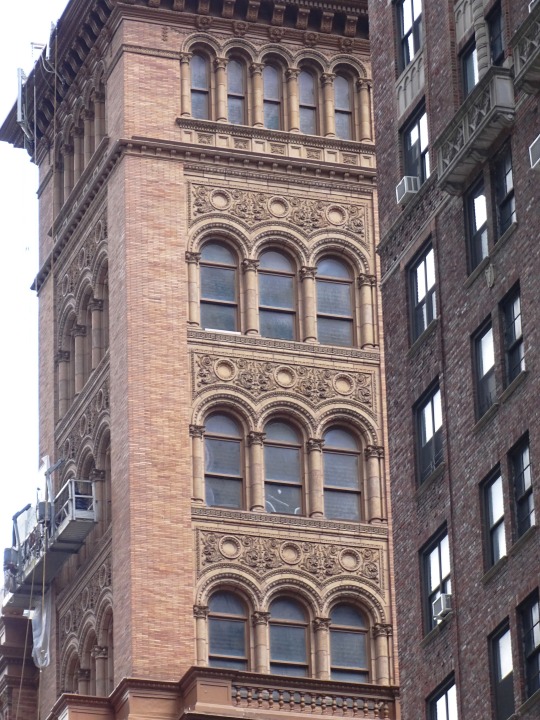
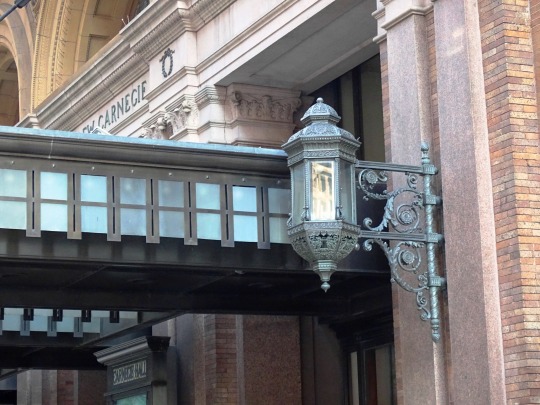
The Music Hall in New York City (later known as Carnegie Hall) has its grand opening and first public performance, with Tchaikovsky as the guest conductor on May 5, 1891.
#Music Hall#Carnegie Hall#881 7th Avenue#opened#5 May 1891#USA#anniversary#US history#a friend of mine played here#William Tuthill#Renaissance Revival#he's a concert pianist#original photography#travel#vacation#summer 2018#lantern#exterior#façade#tourist attraction#landmark#Midtown Manhattan#New York City
9 notes
·
View notes
Photo

◾️ Cᥲrᥒᥱgιᥱ Hᥲᥣᥣ ◾️ . 📍#facts . English (Spanish below) ———————————————————— ✔️ Carnegie Hall first opened its doors in 1891. Located on the corner of 57th Street and Seventh Avenue, it is a national historic landmark that comprises three venues: Stern Auditorium / Perelman Stage, Zankel Hall, and Weill Recital Hall. . 🗽 Designed by architect William Burnet Tuthill and built by philanthropist Andrew Carnegie , it is one of the most prestigious venues in the world for both classical music and popular music. . 🤚Carnegie Hall has its own artistic programming, development, and marketing departments, and presents about 250 performances each season. . 🍁 Carnegie Hall has 3,671 seats, divided among its three auditoriums. . 👣 The exterior is rendered in narrow Roman bricks of a mellow ochre hue, with details in terracotta and brownstone. The foyer avoids typical 19th century Baroque theatrical style with the Florentine Renaissance manner of Filippo Brunelleschi's Pazzi Chapel. . Spanish ———————————————————— ✔️ Carnegie Hall abrió sus puertas por primera vez en 1891. Ubicado en la esquina de 57th Street y Seventh Avenue, es un hito histórico nacional que comprende tres lugares: Stern Auditorium / Perelman Stage, Zankel Hall y Weill Recital Hall. . 🗽 Diseñado por el arquitecto William Burnet Tuthill y construido por el filántropo Andrew Carnegie, es uno de los lugares más prestigiosos del mundo tanto para música clásica como popular. . 🤚Tiene sus propios departamentos de programación artística, desarrollo y marketing, y presenta alrededor de 250 actuaciones cada temporada. . 🍁 Carnegie Hall tiene 3.671 asientos, divididos entre sus tres auditorios. . 👣 El exterior se presenta en estrechos ladrillos romanos de un tonalidad ocre suave, con detalles en terracota y piedra rojiza. El vestíbulo evita el típico estilo teatral barroco del siglo XIX con el estilo renacentista florentino de la Capilla Pazzi de Filippo Brunelleschi. . #carnegiehall #carnegie #hall #music #musician #art #artist #shotoniphone #blackandwhite (at Carnegie Hall) https://www.instagram.com/p/B2ZRHb3BFaK/?igshid=9zvkra13t222
0 notes
Text
First Ladies: Anna Tuthill Symmes Harrison
First Ladies: Anna Tuthill Symmes Harrison
Anna Harrison became the first wife of a sitting President, to become his widow. She was also the grandmother of a future president, Benjamin Harrison.
young Anna Tuthill Symmes Harrison
Anna Elizabeth Symmes was born on July 25, 1775 in Morristown, New Jersey. She was the daughter of Judge John Cleves and Anna Tuthill Symmes. Her father served as Chief Justice of the New Jersey Supreme Court.
I…
View On WordPress
#Anna Tuthill Symmes Harrison#family of William Henry Harrison#First Ladies#grandmother of President Benjamin Harrison#why did William Henry Harrison&039;s wife not come to the White House#wife of William Henry Harrison
0 notes
Text
Grand Opening of New York City’s Carnegie Hall (1891)
Grand Opening of New York City’s Carnegie Hall (1891)
Grand Opening of New York City’s Carnegie Hall (1891)
Enjoy some interesting content from our friends at TheFreeDictionary.Com Carnegie Hall has long been the most famous concert hall in the US. Admired for its beauty and superb acoustics, it was designed in a Neo-Italian Renaissance style by architect William Burnet Tuthill and was endowed by industrialist Andrew Carnegie at the insistence of…
View On WordPress
0 notes
Text
EVERY UNITED STATES PRESIDENT
1. George Washington April 30, 1789 - March 1797
Vice-President: John Adams
First Lady: Martha Dandridge
John Adams March 4, 1797 - March 4, 1801
Vice-President: Thomas Jefferson
First Lady: Abigail Smith
Thomas Jefferson March 4, 1801 - March 4, 1809
Vice-President: Aaron Burr March 4, 1801 - March 4, 1805
George Clinton March 4, 1805 - March 4, 1809
First Lady: Martha Jefferson
James Madison March 4, 1809 - March 4, 1817
Vice-President: George Clinton March 4, 1809 - April 20, 1812 (Died in office)
Office vacant April 20, 1812 - March 4, 1813 (Blance of Clinton’s term)
Elbridge Gerry March 4, 1813 - November 23, 1814 (Died in office)
Office vacant November 23, 1814 - March 4, 1817
First Lady: Dolley Payne
James Monroe March 4, 1817 - March 4, 1825
Vice-President: Daniel D. Tompkins
First Lady: Elizabeth Kortright
John Quincy Adams March 4, 1825 - March 4, 1829
Vice-President: John C. Calhoun
First Lady: Louisa Catherine Johnson
Andrew Jackson March 4, 1829 - March 4, 1837
Vice-President: John C. Calhoun March 4, 1929 December 28, 1832 (Resigned from office)
Office vacant (Balance of Calhoun’s term)
Martin Van Buren December 28, 1833 - March 4, 1837
First Lady: Emily Donelson
Martin Van Buren March 4, 1837 - March 4, 1841
Vice-President: Richard M. Johnson
First Lady: Sarah Yorke Jackson
William Henry Harrison March 4, 1841 - April 4, 1841
Vice-President: John Tyler
First Lady: Sarah Angelica Singleton
John Tyler April, 4 1841 - March 4, 1845
Office vacant
First Lady: Anna Tuthill Symmes
James K. Polk March 4, 1845 - March 4, 1849
Vice-President: George M. Dallas
First Lady: Jane Irwin Harrison
Zachary Taylor March 4, 1849 - July 9, 1850
Vice-President: Millard Fillmore
First Lady: Letitia Christian
Millard Fillmore July 9, 1850 - March 4, 1853
Office vacant
First Lady: Elizabeth Priscilla Cooper
First Lady:
Franklin Pierce March 4, 1853 - March 4, 1857
Vice-President: William R. King March March 4 - April 18, 1853 (Died in office)
James Buchanan March 4, 1857 - March 4, 1861
Vice-President: John C. Breckinridge
First Lady: Julia Garn
Abraham Lincoln March 4, 1861 - April 15, 1865
Vice-President: Hannibal Hamlin March 4, 1861 - March 4, 1865
Andrew Johnson March 4 - April, 1865
Andrew Johnson April 15, 1865 - March 4, 1869
Office vacant
Ulysses S. Grant March 4, 1869 - March 4, 1877
Vice-President: Schuyler Colfax March 4, 1869 - March 4, 1873
Henry Wilson March 4, 1873 - November 22, 1875 (Died in office)
Office vacant (Balance of Wilson’s term)
Rutherford B. Hayes March 4, 1877 - March, 1881
Vice-President: William A. Wheeler
James A. Garfield March 4, 1881 - September 19, 1881
Vice-President: Chester A. Arthur
Chester A. Arthur September 19, 1881 - March, 1885
Office vacant
Grover Cleveland March, 1885 - March 4, 1889
Vice-President: Thomas A. Hendricks March 4 - November 25, 1885 (Died in office)
Office vacant (Balance of Hendricks’ term)
Benjamin Harrison March 4, 1889 - March 4, 1893
Vice-President: Levi P. Morton
Grover Cleveland March, 1893 - March, 1897 (again)
Vice-President: Adlai Stevenson
William McKinley March, 1897 - September 14, 1901
Vice-President: Garret Hobart March 4, 1897 - November 21 1899 (Died in office)
Office vacant (Balance of Hobart’s term)
Theodore Roosevelt March 4 - September 14, 1901
Theodore Roosevelt September 1901 - March 4, 1909
Office vacant September 14, 1901 - March 4, 1905
Charles W. Fairbanks March 4, 1905 - March 4, 1909
William Howard Taft March 4, 1909 - March 4, 1913
Vice-President: James S. Sherman March 4, 1909 - October 30, 1912 (Died in office)
Office vacant (Balance of Sherman’s term)
Woodrow Wilson March 4, 1913 - March 4, 1921
Vice-President: Thomas R. Marshall
Warren G. Harding March 4, 1921 - August 2, 1923
Vice-President: Calvin Coolidge
Calvin Coolidge August 2, 1923 - March 4, 1929
Office vacant August 2, 1923 - March 4, 1925
Charles G. Dawes March 4, 1925 - March 4, 1929
Herbert Hoover March 4, 1929 - March 4, 1933
Vice-President: Charles Curtis
Franklin D. Roosevelt March 4, 1933 - April 12, 1945
Vice-President: John N. Garner March 3, 1933 - January 20, 1941
Henry A. Wallace January 20, 1941 - January 20, 1945
Harry S. Truman January 20 - April 12, 1945
Harry S. Truman April 12, 1945 - January 20, 1953
Office vacant April 12, 1945 - January 20, 1949
Alben W. Barkley January 20, 1949 - January 20, 1953
Dwight D. Einsenhower January 20, 1953 - January 20, 1961
Vice-President: Richard Nixon
John F. Kennedy January 20, 1961 - November 22, 1963
Vice-President: Lyndon B. Johnson
Lyndon B. Johnson November 22, 1963 - January 20, 1969
Office vacant November 22, 1963 - January 20, 1965
Hupert Humphrey January 20, 1965 - January 1969
Richard Nixon January 20, 1969 - August 9, 1974
Spiro Agnew January 20, 1969 - October 10, 1973 (Resigned from office)
Office vacant October 10 - December 6, 1973
Gerald Ford December 6, 1973 - August 9, 1974
Gerald Ford August 9, 1974 - January 20, 1977
Office vacant August 9 - December 19, 1974
Nelson Rockefeller December 19, 1974 - January 20, 1977
Jimmy Carter January 20, 1978 - January 20, 1977 - January 20, 1981
Vice-President: Walter Mondale
Ronald Reagan January 20, 1981 - January 20, 1989
Vice-President: George H. W. Bush
George H. W. Bush January 20, 1989 - January 20, 1993
Vice-President: Dan Quayle
Bill Clinton January 20, 1993 - January 20, 2001
Vice-President: Al Gore
George W. Bush January 20, 2001 - January 2009
Vice-President: Dick Cheney
Barack Obama January 20, 2009 - January 2017
Vice-President: Joe Biden
Donald Trump January 20, 2017 - Incumbent
Vice-President: Mike Pence
0 notes
Text
Une étoile sur le point d'exploser produit une magnifique spirale de gaz
Cette image n’est pas une simulation ni un dessin. Il s’agit bien d’une image réelle, obtenue dans l’infra-rouge. Il s’agit d’un système stellaire comme on n’en avait encore jamais vu auparavant. Il y a ici un triplet d’étoiles ayant sculpté d’élégantes volutes de gaz et de poussière, mais dont l’une d'entre elles serait sur le point d’exploser.
Ce système, nommé officiellement 2XMM J160050.7–514245 a été baptisé Apep, du nom d’un dieu Egyptien à tête de serpent spécialisé dans le chaos… Il se situe à seulement 8000 années-lumière, et sa particularité, outre son esthétique photogénique, est qu’il pourrait être un sérieux candidat émetteur de bouffée de rayons gamma, le premier du genre connu dans notre galaxie.
Les deux étoiles principales du triplet sont toutes les deux des étoiles dites de Wolf-Rayet, des étoiles massives, chaudes et lumineuses. Joseph Callinghan (Université de Sydney), et son équipe ont observé Apep avec plusieurs télescopes depuis les ondes radio jusqu’aux infra-rouge avec le Anglo-Australian Telescope (AAT) et le Very Large Telescope (VLT) avec sa caméra VISIR. Ce qu’ils ont réussi à mettre en évidence dans ce système, c’est la présence d’un vent stellaire extrêmement rapide qui s’échappe des deux étoiles principales, à une vitesse de 3400 km/s ! La forme spiralée de la nébuleuse de poussière et de gaz entourant le couple d’étoiles est produite d’après les chercheurs par le mouvement de rotation des étoiles situées au centre, qui a pour effet d’injecter de la poussière dans le vent de gaz en rapide expansion.
Mais le problème, c’est justement la différence de vitesse d’expansion entre les vents stellaires qui est calculée à partir des formes observées et la vitesse de la poussière : un facteur 6 entre les deux… Pour expliquer ces émissions de particules si rapides, ou cette vitesse de poussière si lente, les astrophysiciens estiment qu’au moins l’une des deux étoiles tournerait sur elle-même très rapidement et serait sur le point de rompre. La chose surprenante avec Apep, c’est que généralement, les étoiles les plus massives, vers la fin de leur vie, produisent des vents rapides qui peuvent atteindre plus de 1000 km/s et qui emportent ainsi de grandes quantités de masse et d’énergie rotationnelle, ce qui doit ralentir la rotation de l’étoile bien avant son effondrement final. Mais ce ne serait pas le cas ici où la vitesse de rotation semble atteindre la vitesse critique.Ils parviennent à cette conclusion en observant que la vitesse d’éjection de matière est plus importante et rapide aux pôles qu’à l’équateur.
Les étoiles de Wolf-Rayet sont classiquement des étoiles très massives qui arrivent à la fin de leur vie et sont vouées à se transformer en supernova. Mais la rotation rapide d’une telle étoile devrait ajouter du piment dans l’explosion. Les chercheurs estiment en effet qu’un tel cataclysme conduirait à la production d’une longue bouffée de rayons gamma, un GRB long (long gamma-ray burst) accompagnant la supernova. Ce phénomène, prédit théoriquement, vient du fait qu’au moment de l’effondrement gravitationnel, quand l’étoile en rotation très rapide ne peut plus fusionner son cœur de fer, le collapse aurait lieu d’abord au niveau des pôles avant d’avoir lieu au niveau de l’équateur.
Nous avons déjà connu de mémoire d’hommes des supernovas dans notre Galaxie, a relativement faible distance, mais encore jamais de bouffée de rayons gamma (qu’elles soient longues ou courtes), les seuls spécimens qui sont observés provenant de galaxies lointaines. Les astrophysiciens ne peuvent pas être certains de l’avenir du système Apep. Il est possible que l’étoile ralentisse et finisse par exploser « normalement », sans ajouter un faisceau de rayons gamma. Mais si ce n’est pas le cas en revanche, 8000 années-lumière pourraient ne pas être suffisantes pour n’avoir aucune conséquence sur Terre si le faisceau de la bouffée gamma se trouvait dans notre direction… En attendant, il nous reste encore nos yeux pour admirer cette magnifique nébuleuse de gaz et de poussières d’une élégance rare et dangereuse.
Source
Anisotropic winds in a Wolf–Rayet binary identify a potential gamma-ray burst progenitor
J. R. Callingham, P. G. Tuthill, B. J. S. Pope, P. M. Williams, P. A. Crowther, M. Edwards, B. Norris & L. Kedziora-Chudczer
Nature Astronomy (19 november 2018)
https://doi.org/10.1038/s41550-018-0617-7
Illustrations
1) Image de Apep obtenue dans l'infra-rouge à la longueur d'on de de 8 microns avec la caméra VISIR du VLT (P. Tuthill/Université de Sydney/ESO)
2) Simulation de l'évolution de la forme de la nébuleuse de Apep sur une la durée d'une demi-révolution entre les étoiles principales, soit 60 ans (Université de Sydney)
via https://ift.tt/2OSGpzi
0 notes
Link
Poltergeist is a 1982 American supernatural horror film directed by Tobe Hooper and starring JoBeth Williams, Craig T. Nelson, and Beatrice Straight. Steven Spielberg wrote and produced the film, but a clause in his contract prevented him from directing another movie while he made E.T. the Extra-Terrestrial. Therefore, Hooper was selected to direct based upon his work on The Texas Chain Saw Massacre. First conceived as a dark horror sequel to Close Encounters of the Third Kind entitled Night Skies, when Spielberg approached Hooper to direct, Hooper was less keen on the sci-fi elements and suggested the idea of a ghost story.[3] Spielberg and Hooper would then go on to collaborate on the first treatment for the film. It is the first and most successful entry in the Poltergeist film series. Set in a California suburb, the plot focuses on a family whose home is invaded by malevolent ghosts that abduct the family's younger daughter.
Released by Metro-Goldwyn-Mayer on June 4, 1982, the film was a major critical and commercial success, becoming the eighth-highest-grossing film of 1982. Years since its release, the film has been recognized as a classic within the horror genre and has gained a cult following. Aside for being nominated for three Academy Awards, the scene of the clown attack was ranked as #80 on Bravo's 100 Scariest Movie Moments[4] and the Chicago Film Critics Association named it the 20th-scariest film ever made.[5] The film also appeared at #84 on American Film Institute's 100 Years...100 Thrills, a list of America's most heart-pounding movies.[6]
The film's success helped spawn a franchise consisting of two sequels, Poltergeist II: The Other Side (1986) and Poltergeist III (1988), and a remake of the same name in 2015.
Plot
Steven and Diane Freeling live a quiet life in an Orange County, California planned community called Cuesta Verde, where Steven is a successful real estate developer and Diane looks after their children Dana, Robbie, and Carol Anne. Carol Anne awakens one night and begins conversing with the family's television set, which is displaying static following a sign-off. The following night, while the Freelings sleep, Carol Anne fixates on the television set as it transmits static again. Suddenly, a ghostly white hand emerges from the television, followed by a violent earthquake. As the shaking subsides, Carol Anne announces "They're here".
Bizarre events occur the following day: a drinking glass of milk spontaneously breaks, silverware bends and furniture moves of its own accord. The phenomena seem benign at first, but quickly begin to intensify. That night, a gnarled backyard tree comes alive and grabs Robbie through the bedroom window. While Steven rescues Robbie, Carol Anne is sucked through a portal in her closet. The Freelings realize she has been taken when they hear her voice emanating from the television set that is tuned to an empty channel.
A group of parapsychologists from UC Irvine—Dr. Lesh, Ryan, and Marty—come to the Freeling house to investigate and determine that the Freelings are experiencing a poltergeist intrusion. They discover that the disturbances involve more than just one ghost. Steven also finds out in an exchange with his boss, Lewis Teague, that Cuesta Verde is built where a cemetery was once located.
After Dana and Robbie are sent away for their safety, Lesh and Ryan call in Tangina Barrons, a spiritual medium. Tangina states that the ghosts inhabiting the house are lingering in a different "sphere of consciousness" and are not at rest. Attracted to Carol Anne's life force, these spirits are distracted from the real "light" that has come for them. Tangina then adds that there is also a demon known as the "Beast", who has Carol Anne under restraint in an effort to restrain the other spirits.
The assembled group discovers that the entrance to the other dimension is through the children's bedroom closet, while the exit is through the living room ceiling. As the group attempts to rescue Carol Anne, Diane passes through the entrance tied by a rope that has been threaded through both portals. Diane manages to retrieve Carol Anne, and they both drop to the floor from the ceiling, unconscious and covered in ectoplasmic residue. As they recover, Tangina proclaims afterward that the house is now "clean".
Shortly thereafter, the Freelings begin the process of moving elsewhere by packing up their belongings. During their last night in the house, Steven leaves for the office in order to quit his job and Dana goes on a date, leaving Diane, Robbie, and Carol Anne alone in the house. The "Beast" then ambushes Diane and the children, aiming for a second kidnapping by attempting to restrain Robbie and Diane. Robbie is attacked by a clown doll in his bedroom, and Diane is attacked by an unseen force that moves her up the wall and over the ceiling in her room. The unseen force drives Diane to the backyard dragging her into the swimming pool. Skeletons surround her as she tries to swim to escape, but she manages to climb out of the pool and make her way back into the house. She rescues the children, and they eventually escape to the outside only to discover coffins and rotting corpses erupting out from the ground in their yard and throughout the neighborhood.
As Steven and Dana return home to the mayhem, Steven confronts Teague after realizing that rather than relocating the cemetery for the development of Cuesta Verde, Teague merely had the headstones moved and the bodies left behind. The Freelings flee Cuesta Verde while the house implodes into the portal, to the astonishment of onlookers. The family checks into a hotel for the night, and Steven rolls the television outside into the walkway.
Cast
Craig T. Nelson as Steven Freeling
JoBeth Williams as Diane Freeling
Dominique Dunne as Dana Freeling
Oliver Robins as Robbie Freeling
Heather O'Rourke as Carol Anne Freeling
Zelda Rubinstein as Tangina Barrons
Beatrice Straight as Dr. Lesh
Richard Lawson as Ryan
Martin Casella as Marty
James Karen as Mr. Teague
Michael McManus as Ben Tuthill
See also
Film portal
Horror fiction portal
United States portal
List of ghost films
0 notes